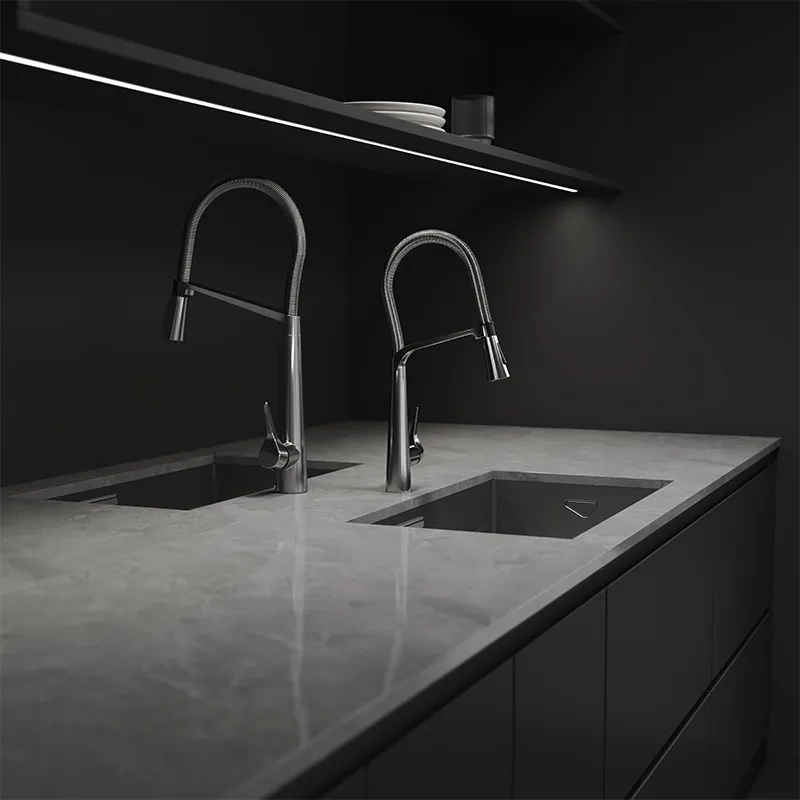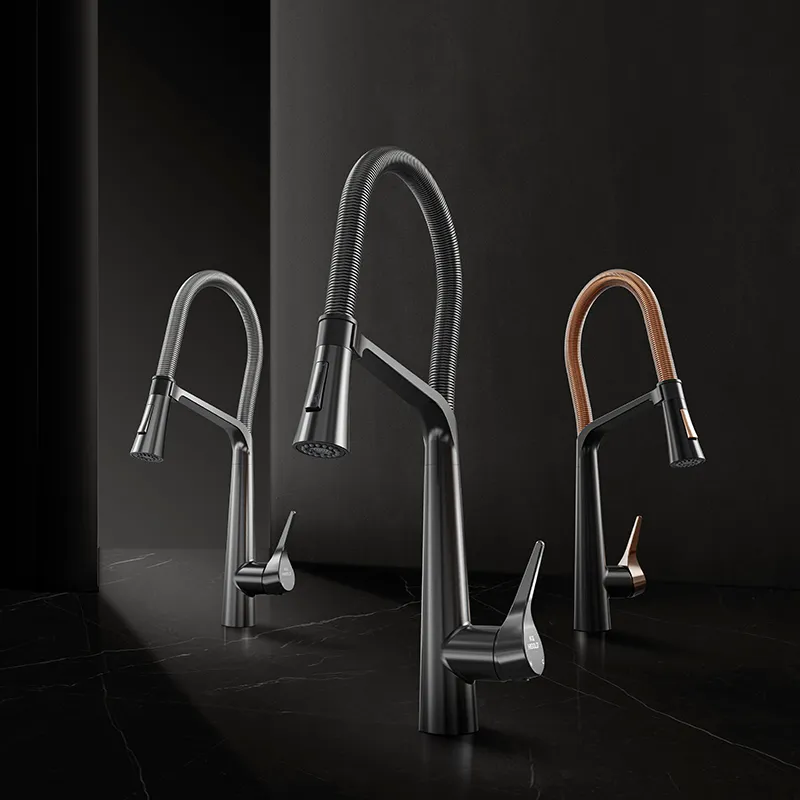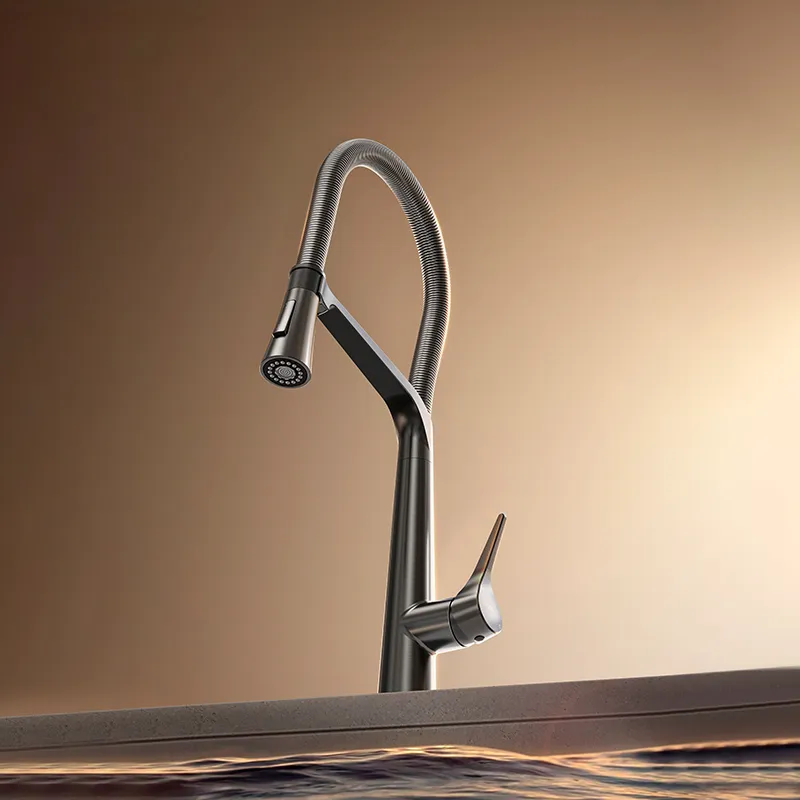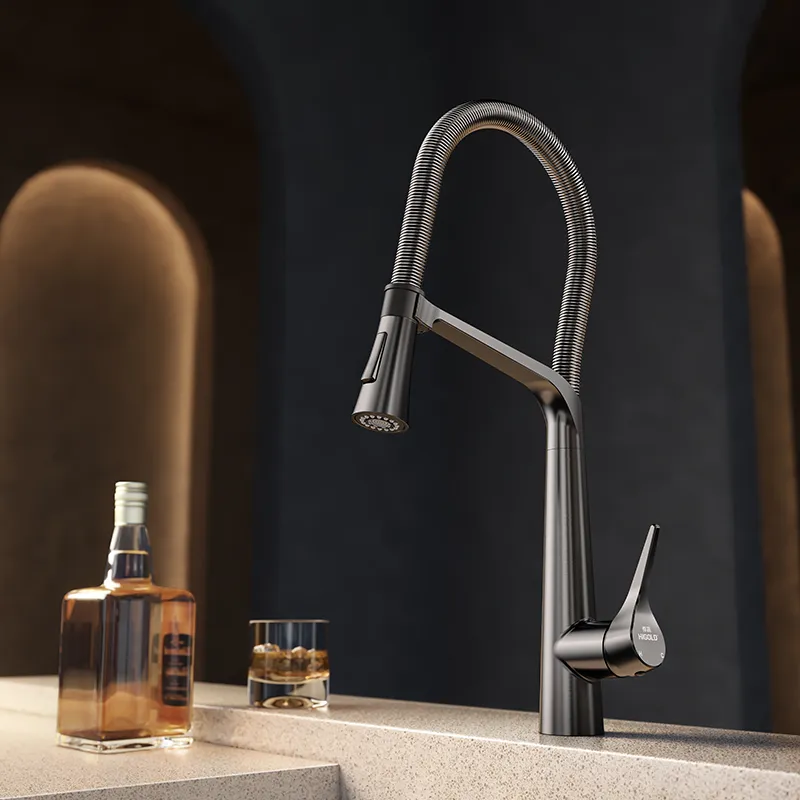In modern kitchens, faucets not only perform daily washing tasks but also directly impact kitchen comfort and water efficiency. In recent years, dual-flow mixer taps have attracted considerable attention due to their flexible hot and cold water flow adjustment and precise water temperature control.
So, can a dual-flow mixer tap be used in a kitchen sink? This article will provide detailed guidance on combining a kitchen sink with a dual-flow mixer tap, covering various aspects, including its definition, operating principle, installation compatibility, materials and durability, safety, key considerations, and maintenance.

Dual-flow mixer taps: What are their features?
A dual-flow mixer tap is a faucet that simultaneously controls the flow of hot and cold water through an internal valve, mixing the water at the outlet. Its core features include:
1. Dual-flow design
The faucet features dual hot and cold water channels, allowing for separate adjustment of the flow of hot and cold water, resulting in different water temperatures.
2. Mixing Function
The internal ceramic or ceramic disc valve core adjusts the hot and cold water ratio, achieving precise control of the outlet water temperature and preventing hot and cold water fluctuations.
3. Multi-Scene Applicability
Dual-flow mixing faucets were originally used for wash basins, but with design optimization, they can also be used in kitchen sinks, vegetable sinks, and other washing applications.
4. Convenient Operation
The handle allows single-handed control of the hot and cold water flow and mixing temperature, improving efficiency and user comfort.
Thus, the advantages of a dual-flow mixing faucet lie not only in temperature control but also in flexibility and comfort.

What are the functional requirements of a kitchen sink?
The kitchen sink is an indispensable component of a home kitchen, and its functional requirements include:
1. Hot and cold water supply
A kitchen sink must meet the hot and cold water needs for washing vegetables, dishes, and food, so the faucet must be able to flexibly adjust the water temperature.
2. Controllable Flow
Different operating scenarios require different water flow rates. For example, rinsing vegetables requires a gentle flow, while washing pots and pans requires a high flow.
3. Installation Space Constraints
Kitchen sink faucets often have limited installation space, so the height, spout location, and mounting hole diameter must match the sink design.
4. Durability and Hygiene
Kitchen faucets are subject to constant contact with water, oil, and detergents. Their materials must be corrosion-resistant and wear-resistant, and their internal structure must be easy to clean.
Choosing the right faucet is crucial given these requirements.

How does a dual-flow mixer faucet work?
Understanding the workings of a dual-flow mixer faucet will help you determine whether it is suitable for a kitchen sink. The basic principles are as follows:
1. Separate Hot and Cold Water Inlets
Dual-flow mixer faucets have separate hot and cold water inlets, with each line feeding the valve core.
2. Valve Core Mixing Adjustment
A ceramic or ceramic disc valve core controls the hot and cold water flow ratio via a handle, thereby precisely adjusting the outlet water temperature. The valve core provides a high seal to effectively prevent leaks.
3. Spout Design
Kitchen faucets typically feature a high-bend or swivel spout for easy cleaning of pots and large dishes. A dual-flow mixer tap mixes hot and cold water at the outlet, delivering water at the ideal temperature.
4. Water Flow Control
High-end dual-flow mixer taps may feature flow control, using a bubbler or internal flow restriction, to balance water conservation and user comfort.
Based on these principles, dual-flow mixer taps can flexibly meet varying temperature and flow requirements in the kitchen.
Is a dual-flow mixer tap suitable for a kitchen sink?
The question, "Is a dual-flow mixer tap suitable for a kitchen sink?" requires analysis from the following perspectives:
1. Mounting Hole Diameter and Space Compatibility
Kitchen sinks typically have single or multiple mounting holes. Dual-flow mixer taps typically support single or three-hole installations and can be adapted to various sinks using a base or adapter.
The height of the water outlet must match the depth of the sink to ensure splash-free washing of large items.
2. Water Temperature and Flow Requirements
Daily kitchen operations require mixing hot and cold water. A dual-flow mixer tap can precisely adjust the temperature to avoid burns and cold water irritation. The high-flow water flow satisfies pot and pan rinsing needs, while the low-flow water flow provides gentle cleaning, making it suitable for a variety of scenarios.
3. Material Durability
The water quality, grease, and detergents in the kitchen environment place certain demands on the faucet material. High-quality dual-flow mixer taps made of copper, stainless steel, or chrome alloy are corrosion-resistant and oxidation-resistant, making them suitable for long-term kitchen use.
4. Safety
The risk of scalding water in the kitchen is high. Dual-flow mixer taps can adjust the temperature using a thermostatic valve or ceramic valve core to reduce the risk of scalding.
The splash-proof design is suitable for kitchen sinks and keeps the worktop clean and tidy.
In summary, dual-flow mixer taps are perfectly suitable for kitchen sinks, but it is important to consider the matching of the sink aperture, water outlet height, material, and flow design.

How to choose the material for a dual-flow mixer tap?
During long-term use, the material of a kitchen faucet directly affects its durability and hygiene. Common materials include:
All-copper
• Advantages: Corrosion-resistant, oxidation-resistant, and long service life.
• Disadvantages: Slightly more expensive, but excellent value and durability.
Stainless Steel
• Advantages: Durable, wear-resistant, bright surface, and easy to clean.
• Disadvantages: Some low-end stainless steels are prone to scale formation and require regular cleaning.
Alloy or Chrome-Plated
• Advantages: Attractive appearance and affordable price.
• Disadvantages: The plating may peel with long-term use, affecting both appearance and service life.
Safety and Comfort of Dual-Flow Mixer Faucets
The advantages of using a dual-flow mixer faucet in the kitchen primarily lie in safety and operational comfort:
• Anti-scalding design: High-end models can set a temperature limit to prevent overheating, making them suitable for high-temperature kitchen environments.
• Splash-proof design: With frequent kitchen washing, a splash-proof design reduces water stains on countertops and improves user comfort.
• Smooth Operation: The ceramic valve core provides a smooth operation experience, and the temperature and flow rate can be adjusted with one hand.
• Water-saving Performance: Dual-flow mixer faucets use an internal flow control design to conserve water while ensuring cleaning efficiency.
Key Points for Choosing a Dual-Flow Kitchen Faucet
When choosing a dual-flow kitchen faucet for your kitchen sink, consider the following:
• Spout Height and Swivel Range: The high-bend spout is suitable for washing large items, and the swivel design allows for versatile use.
• Valve Cartridge Quality: Ceramic or ceramic disc valve cartridges ensure long-term smooth operation and durability.
• Material and Finish: Preferred materials include copper or stainless steel, with chrome or nickel plating for corrosion resistance and easy cleaning.
• Hot and Cold Water Adjustment: Precise temperature control and smooth operation prevent temperature fluctuations.
• Accessories and After-Sales Service: Comprehensive accessories and after-sales service ensure long-term use, preventing leaks and installation difficulties.
Maintenance and Care of a Dual-Flow Faucet
To ensure long-term stable use of your kitchen sink and dual-flow faucet, please observe the following maintenance methods:
• Regularly clean the spout: Prevent scale and debris from clogging and ensure smooth water flow.
• Check the seals: Regularly inspect the rubber or silicone seals to prevent leaks.
• Avoid impact with hard objects: Prevent scratches on the coating or damage to the valve core.
• Control water pressure: If household water pressure is too high, install a pressure reducing valve to protect the faucet's internal structure.
• Regularly operate the handle: Keep the valve core flexible and smooth, preventing prolonged use that could cause sticking or leaks.
"Can a dual-flow mixer tap be used in a kitchen sink?"
Absolutely. Its core advantages are:
• Precise control of hot and cold water mixing: Meet the varying temperature requirements of kitchen washing.
• Flexible dual-flow design: Separate or combined water flow accommodates a variety of cleaning scenarios.
• Durable materials: Made of copper, stainless steel, or alloy, adapt to complex kitchen environments.
• Comfortable and safe operation: Temperature control and splash-proof design reduce the risk of burns and operating inconvenience.
• Water conservation and efficiency: Optimized water flow design balances water conservation with cleaning efficiency.
Choosing a high-quality dual-flow mixer tap for your kitchen sink not only improves kitchen operation comfort but also extends the life of the faucet, making it an ideal water solution for modern kitchens.
What kind of after-sales service does Higold provide?
Higold not only supplies high quality sinks but also provides reliable after-sales support for global customers. Our team ensures smooth purchasing, wholesale supply, and timely delivery. With certifications and factory-direct guarantees, buyers can purchase confidently, knowing they are partnering with a trusted manufacturer in China.


